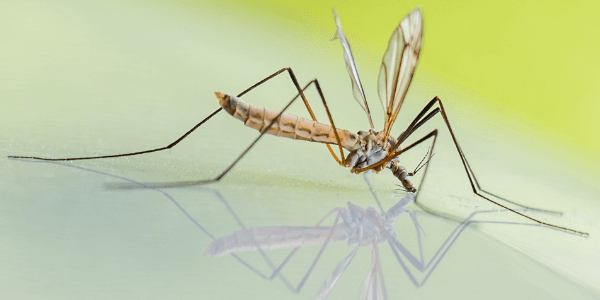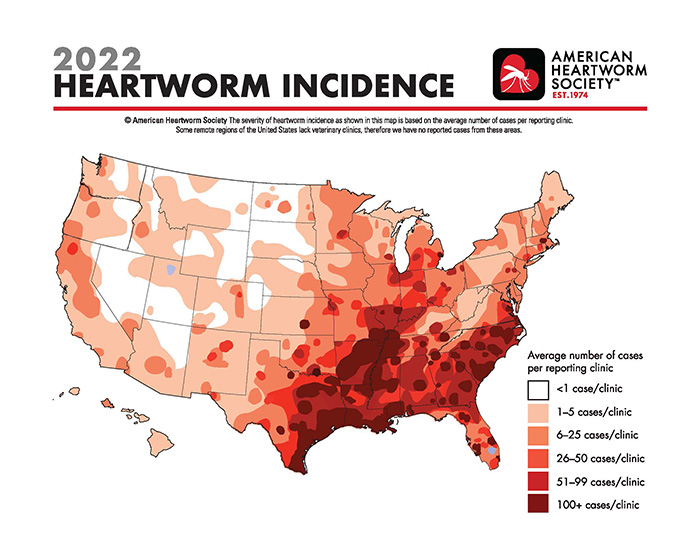
Normally, when things are associated with the heart (warmhearted, joyful heart), people have thoughts of love and other positive emotions or feelings.
Well, there are no warm and fuzzy emotions or feelings when it comes to heartworm disease.
This worldwide disease is serious and potentially fatal.
The good news is that it is preventable for both dogs and cats.
Skip to section:
A Brief History of Heartworm Disease
In 1586, Chez Jean Wolfe found what he called a ‘monster’ in his horse’s heart. That ‘monster’ was the parasitic worm Dirofilaria immitis, a.k .a. heartworms.
It wasn’t until 300 years later, on the coast of southeastern United States, that canine heartworms were discovered. Even though in 1847, the earliest case of heartworms occurred in South America, it wasn’t until 1875 that it was officially reported.
The same organism was found in cats in the 1920s.
In 1974, the American Heartworm Society was founded due to the growing concern of veterinary practitioners and scientists about heartworm disease.
What Is Heartworm Disease?
The medical term for heartworm disease is dirofilariasis since the disease is caused by the parasitic worm Dirofilaria immitis.
Adult heartworms are about a foot long, and they live and cause disease in the heart, lungs, and associated vessels. Hence the name heartworm disease. In dogs, the adult heartworm can live for 5 to 7 years, whereas in a cat, they live up to 2 or 3 years.
They predominately affect the pulmonary arteries, causing inflammation, vascular dysfunction, and high blood pressure that affects the arteries in the lungs and right side of the heart (pulmonary hypertension). The result is severe lung disease, heart failure, and damage to other body organs. These effects are why heart disease is such a serious and potentially fatal disease.

How Does This Big Nasty Worm Get Into a Pet’s Heart?
The short version is that a mosquito bites a host, like an infected dog or coyote with heartworms, becomes infected itself, and then when it bites a healthy dog or cat, it infects them. That’s all it takes – one bite – for dogs and cats to become infected.
In rare cases, humans can be accidental hosts for heartworms, but it doesn’t result in microfilaria production. Mosquitoes transmit other diseases like Zika, West Nile virus, and maleria to people as well.
Typically, I am the type that likes a bit more detail to understand things. So, for those of you who are like me, here it is. For those that don’t, feel free to skip ahead to how pets get infected with heartworms.
The lifecycle and how heartworms are spread and cause disease is a bit more complex than what I stated above.
To start, it involves a definitive host and an intermediate host.
Natural or definitive hosts are organisms where a parasite completes its life cycle (finishes maturing). The natural or definitive hosts for heartworms are dogs, wild canids such as wolves and foxes, as well as raccoons. The immature heartworm (microfilaria), while living inside a definitive host, matures, mates, and produces offspring (microfilaria) over a period of 6 to 7 months. The offspring move into the bloodstream.
Without treatment, the numbers increase tremendously within the definitive host’s body (often no symptoms are present yet) and then, via an intermediate host, can be transferred to another host. Millions of microfilaria can be produced in the 5 to 7-year lifespan of the adult female heartworm.
Note: Heartworm disease in cats is different than in dogs. Cats are an atypical host for heartworms. The worms generally do not survive to the adult stage. The worm burden of cats is typically only 1 to 3 worms as compared to the average of 15 worms in dogs (BUT the range in dogs can be 1 to 250 worms!). Cats can have no adults but still be infected with heartworms, which can cause the disease to go undetected. Immature worms can cause serious damage to a cat’s body.
An intermediate host is an organism where the immature or nonproductive form of the parasite lives until it can be moved to a definitive host. The intermediate host for heartworms is the mosquito. When feeding on an infected host, the mosquito acquires the microfilaria. The microfilaria then continues to develop within the mosquito over a one-to-four-week period into an infective stage. Once the infective larvae have matured, they migrate to the mosquito’s mouthpiece so that they can migrate into the bite wound on the host’s skin. Thus continuing the life cycle.

There Is Only One Way to Get Heartworm Disease – Through a Mosquito Bite!
An important part of understanding the life cycle is that dogs or cats cannot develop heartworm disease from being near another infected animal. The only way to spread the disease is through the bite of an infected mosquito.
Did you know mosquitoes thrive in the warm periods following rain and when there’s standing water in your yard (birdbaths, pools, empty pots, etc.)? And did you know that a mosquito can develop from an egg to an adult mosquito in as little as 4 days?
Every three years, the American Heartworm Society gathers data from veterinary clinics across the U.S. and releases incident maps. You can see the charts and the comparisons over time on their website.

Sadly, the conventional wisdom that heartworm disease is only a concern during the warmer months of the year has proven to be wrong. Mosquitoes continue to adapt to and thrive in cooler climates and sometimes even survive throughout the winter in homes! And unfortunately, another consequence of climate change is that mosquito populations are growing and spreading in their distribution.
What Are the Symptoms of Heartworm Disease?
Symptoms in Dogs
The severity of heartworm disease is affected by several factors. These include:
- The number of worms present within the dog’s body
- The length of the infection
- The dog’s body’s response to the presence of the heartworms
- Activity level of the dog
Symptoms are not always evident in dogs with low worm counts, recent infections, or those that are not active. For example, an inactive, sedentary dog with a heavy worm burden may not have observable symptoms.
Symptoms are often obvious if there is a heavy worm burden, the infection is present for a long time, or the level of activity is high.
Symptoms of heartworm disease include:
- Cough – the cough starts off as occasional, and as the disease progressives it becomes persistent, often moist
- Exercise intolerance
- Decreased appetite
- Weight loss
- Breathing difficulty
- Bluish discoloration of mucous membranes (around the mouth) or skin
- Fainting or passing out (syncope)
- Collapse
- Heart failure can develop as heartworm disease progresses. A symptom of this is a distended belly due to fluid buildup in the abdomen.
A small percentage of dogs with heavy worm burden can develop a life-threatening condition called caval syndrome. Immediate surgery is required to remove the heartworms, as it is the only treatment option. The surgical procedure is risky. Most dogs with caval syndrome die even if surgery is performed.
Symptoms in Cats
As amazing as cats are, they tend not to make diagnosing medical issues simple, especially heartworm disease.
The symptoms associated with heartworm disease are not specific to just this disease. They can be very subtle or very dramatic.
A sudden onset of coughing and rapid breathing are the most common symptoms noticed.
In addition to coughing and rapid breathing, cats may have the following symptoms:
- Weight loss
- Vomiting
- Respiratory failure
- Sudden death
How Is Heartworm Disease Diagnosed?
Since heartworm disease is a progressive disease, the earlier it is detected, the better the chances of recovery are for your pet. Routinely having your pet tested for heartworms is highly recommended.
There are different types of blood tests that can be used to diagnose heartworm disease.
Diagnosing Dogs
Dogs are often tested in the veterinary hospital using an antigen test that detects the presence of adult FEMALE worms. An active infection is indicated with a positive test. However, further diagnostics to verify a dog truly has the disease, as well as to assess any damage done to the heart and lungs, is recommended before a dog is treated for heartworm disease.
A negative test doesn’t guarantee that a dog has no infection. If the worms are present in low numbers or are all males, a test can potentially be negative. A repeat test in 5 to 6 months is recommended if a dog has missed or been off heartworm prevention.
Diagnosing Cats
It is harder to detect heartworm infections in cats than in dogs. Therefore, it is recommended that cats have both the antibody (this test checks for heartworm larvae exposure) and antigen tests.
An active infection may be present if an antibody test is positive. Antibody tests are sensitive but will be positive even if the heartworms have all died. It will also be positive if adult heartworms are present in places other than the heart, as well as if there are mature larvae that are not yet adults.
Antigen tests can only detect adult FEMALE heartworms, thus making them very specific but not as sensitive as the antibody test. The test can be false-negative if a cat does not have enough female adult heartworms (they typically have fewer adults than dogs) or if all the heartworms present are male; this can cause the antigen test to be false-negative.
If both tests are positive, it confirms a cat has a heartworm infection. A positive result on both tests doesn’t occur with all infected cats. This is why if a veterinarian suspects heartworm disease in cats, further diagnostic tests are needed.

How Is Heartworm Disease Treated?
Treatment for Dogs
Did you know that there are treatment options for heartworm disease for dogs? Treatment is available; however, it is important to remember that it is always better to prevent heartworm disease than to treat it. These treatments can be difficult on your dog, time-consuming, expensive, and can cause serious life-threatening complications. Yikes and yikes — right!
There is an arsenic-containing drug that is FDA-approved to kill adult heartworms. The treatment involves a series of deep injections into the muscle along the spine.
If dogs are also positive for microfilariae, they must also be treated for that. There are a few different FDA-approved medications for the treatment of microfilaria.
Your veterinarian may recommend additional medications, such as pain medications, anti-inflammatories, or sedatives, as part of the treatment protocol.
It is critical to give any medications as directed as well as follow your veterinarian’s instructions in order to prevent complications and have a successful treatment.
The length of the entire treatment varies depending on the current health of the dog as well as the treatment protocol needed, such as a series of two injections versus three. Additionally, the length of treatment is extended for dogs that also require microfilaria treatment. In general, the process takes about four to six months.
Note: During treatment and after, dogs MUST have very restricted activity, including no running, jumping, or playing. If dogs are active, this could result in severe complications, such as a blood clot or clump of worms blocking circulation through the lungs. The result is a stroke or sudden death. Your veterinarian will tell you when your dog can resume normal activity.
Treatment for Cats
There are no approved drugs for the treatment of heartworm disease in cats. It is not safe for cats to be treated with the drugs used to treat canine heartworm disease.
Treatment mainly involves routine monitoring (blood tests and chest X-rays) and management of symptoms. Typically, several months of treatment are needed.
For cats that don't have any symptoms (asymptomatic) but have evidence of inflammation or scarring in the lungs, prednisolone is often prescribed.
For symptomatic and severe cases, hospitalization may be needed. While hospitalized, cats may receive IV fluids, medications to treat heart and lung symptoms, antibiotics, pain medications, as well as other potential treatments.
Cats suffering from an acute case of heartworm disease (which can occur with only one worm present) can die suddenly.
Heartworm prevention is even more critical for cats than dogs since there is no treatment. It takes between two to four years for the infection to clear, during which time symptoms have to be managed. Some cats can survive for an extended period of time, between 1.5 and 4 years from diagnosis.
About 50% of the cats that do not survive suddenly die because of acute respiratory failure.

Can Heartworm Disease Be Prevented?
The old adages about Prevention Being The Best Medicine and An Ounce of Prevention Being Worth a Pound of Cure (both of which we at PREVENTIVE Vet couldn’t agree more with!) apply 100% to heartworm disease.
There are several safe and affordable heartworm preventives for both dogs and cats. Your veterinarian can guide you on which heartworm prevention program will be best for your pets, as not all products are appropriate for all sizes, ages, or breeds of dogs and cats. These are also the reasons why these medications are prescription-only meds. For example, if a dog is less than 6 months of age but needs heartworm prevention, they can’t receive the heartworm prevention injection called ProHeart 6, or if they are less than 12 months of age, they can’t get ProHeart 12. Certain breeds of dogs (e.g., Collies), due to an inability to metabolize it, may not be able to receive heartworm prevention containing ivermectin. Any pet is at risk of a reaction or an allergic response to heartworm preventatives and, if they occur, require veterinary care. Some heartworm preventatives are in a topical form and can irritate the skin, and these are side effects that a veterinarian needs to determine if they are temporary or could lead to bigger issues.
It is recommended that dogs and cats be started on heartworm prevention as young as 6 to 8 weeks of age. This helps prevent any chances of them being infected if it is given routinely.
Why is your pet retested if they go off of heartworm preventatives before getting another prescription?
If your pet has been off heartworm prevention (5 months or more), it will be recommended to do a quick blood test, depending on how long they were off, to check for the presence of heartworms first before (re)starting a preventative. This is important since heartworm preventatives DO NOT kill adult heartworms. If dogs remain infected with adult heartworms, they can become sick. It can potentially be harmful or fatal to give heartworm prevention to dogs that are infected with adult heartworms. The presence of heartworms will change the treatment/prevention protocol your veterinarian recommends.
Note: There is a bonus in some heartworm-preventative products! Many preventatives also help control intestinal worms in dogs and cats, and several also help to control fleas!
Check the Companion Animal Parasite Council for their quick product reference guide.
It’s also a good idea to encourage all your pet-owning friends and neighbors to get and keep all of their pets on effective heartworm preventatives throughout the year since infected cats and dogs serve as “reservoir hosts” (meaning that a mosquito will itself become infected when they bite them, therefore making that mosquito capable of spreading the worms from that cat/dog to yours). This may seem like overkill, but nothing is 100% preventable; we all can easily forget a month of prevention, or our pet secretly didn’t take it, thus leaving them vulnerable.
Besides providing your pet with monthly heartworm prevention, managing mosquitoes around your pet and home can be helpful in decreasing the spread of heartworms. Read our article about safe ways to repel mosquitoes.
PLEASE practice prevention and practice it year-round for all your pets. It really is better… for everyone. We’re all in this together!



